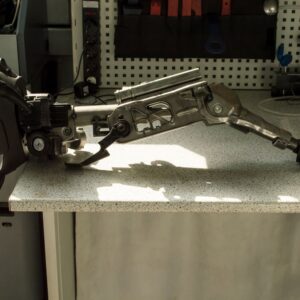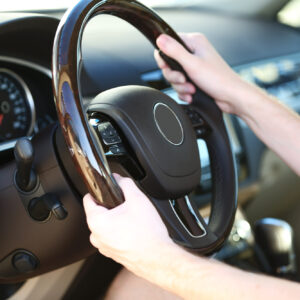There are generally three types of steering linkage designs found in vehicles: parallelogram, cross-steer, and Haltenberger systems.
In this article, we’ll focus on the parallelogram system, the type of steering linkage you’ll find in most modern vehicles.
What Is a Parallelogram Steering Linkage?
In a parallelogram steering system, the opposing sides are parallel at an equal distance, hence the name. The steering linkage has an idler arm on the right side and a pitman arm on the left. These two components help stabilize the center link, preventing it from bobbing up and down while the vehicle travels over bumps.

How Does a Parallelogram Steering Linkage Work?
The pitman arm moves every time the steering wheel rotates. From the pitman arm, this steering movement is also transferred to the sector shaft, center link, and tie rods before reaching the steering knuckle on each front wheel.
Meanwhile, the idler arm supports the passenger side of the center link and keeps the steering linkage level with the road.

Parallelogram Steering Linkage Components
A typical parallelogram steering linkage setup has the following parts:
- Center link
- Tie rods, tie rod ends, and tie rod adjusting sleeves
- Pitman arm
- Idler arm
- Right and left steering arms
Center Link
The center link goes by many names, including “drag link,” “connecting link,” “connecting rod,” “relay rod,” and “intermediate rod.”
The center link transfers torque from the steering gear to the steering knuckles, moving the front wheels in the process. Without the center link, the driver won’t be able to steer the vehicle in a certain direction.
The center link also plays an important role in maintaining wheel alignment. Together with the tie rods, the center link ensures that both front wheels turn at the same time.
A vehicle with a parallelogram steering linkage can either have a wear or non-wear center link.
A wear center link usually comes with a ball-and-socket joint that can wear out after some time. Meanwhile, a non-wear center link has holes for fitting ball joint studs.
Tie Rods, Tie Rod Ends, and Tie Rod Adjusting Sleeves
Tie rods connect the steering rack to the steering knuckles.
Pitman Arm
The pitman arm is located on the left side of the steering linkage and is attached to the gearbox. It connects the steering linkage to the steering column and turns the center link as the steering wheel moves.

Idler Arm
The idler arm keeps the center link parallel to the road surface. It also permits a swivel movement while preventing an up-and-down movement.
One end of the idler arm is usually attached to a vehicle’s frame or chassis while the other end is connected to the center link.
Right and Left Steering Arms
The steering gear transfers torque to the steering arms, turning the wheels in the process.
Service Life of Parallelogram Steering Components
Steering components are built to last a long time, but they need to be replaced in some cases to restore your vehicle’s good performance.
Check out this table on how long the common steering components can last before needing a replacement.
| Part Name | Estimated Service Life |
| Idler arm | 40,000-60,000 miles |
| Outer tie rod ends | 60,000-100,000 miles |
| Inner tie rod ends | 80,000-120,000 miles |
| Center link | 90,000-130,000 miles |
| Pitman arm | 100,000-150,000 miles |
Note by Richard McCuistian, ASE Certified Master Automobile Technician: Note that most vehicles driven on smooth roads may not ever need any of these parts. Rough roads or oversize tires wear the parts out much faster.
Diagnosing Steering Linkage Problems
Bent, broken, and binding components can easily cause steering problems. To check for steering linkage issues, perform a visual test to check for busted grease boots and bent parts, and then do a dry park check, an off ground check, and a jounce or rebound test.
Dry Park Check
With the steering wheel unlocked for free turning, but with the engine not running, the transmission in park, and the park brake applied, have an assistant gently move the steering wheel back and forth while you watch all the steering parts using a bright light. You’ll be able to find any worn out steering parts this way. The ball joints will need to be tested a different way, but you can check the tie rod ends and center link this way.
Off the Ground Check
With the vehicle raised in the air, you can also grab the front wheels at the 9 and 3 o’clock positions and check for worn tie rods, but somebody needs to be watching to see which part is worn out, including the pitman arm (when it has a joint) and the idler arm.
Next, grab each front wheel at the 12 and 6 o’clock positions to check for possible ball joint problems.
Jounce Test
Park the vehicle on a hard, level surface. Keep the wheels straight and the steering wheel in the unlocked position. Then, make the vehicle bounce by applying force to the front bumper.
Keep an eye on the steering wheel. It shouldn’t move while the vehicle bounces up and down. If it does, inspect the steering linkage, suspension arm, or steering rack for bent components.
Under-Vehicle Inspection
To perform a thorough under-vehicle inspection, it’s recommended to hoist your vehicle to have a clear view of the parts.
First, inspect each part that could have been damaged due to road debris or minor collisions on the roadway.
The next step is to inspect the idler arm. Use a hand force of about 25 lbs. up and down the arm. The total movement shouldn’t exceed 1/4 in.
Test all steering linkage components by hand, and check for vertical or side-to-side looseness.
When testing tie rod ends, keep in mind that it’s normal for them to rotate in their sockets. However, endplay in any tie rod should always be zero.
Remember that the wheels should be straight when testing the components. Inspecting the steering linkage with the wheels turned can make some parts appear loose because of the angle.
How to Get a Quality Replacement Steering Linkage Components
As you can imagine, keeping your parallelogram steering linkage setup in order means you have to keep all its components in good shape. If any of the parts in the setup are bent out of shape or otherwise deformed, then the parallelogram won’t be properly aligned, leading to steering issues. Thankfully, you can find many of the different steering linkage components on CarParts.com.
CarParts.com has a wide range of quality aftermarket parts in our catalog. We offer parts at various prices from trusted manufacturers and suppliers to suit different budgets. If you have questions about our current deals and prices, you can always contact our helpful and friendly customer service team. They’re happy to help around the clock.
Keep your vehicle’s steering linkage setup in tip-top shape. Buy replacement center links or other steering linkage components from CarParts.com today.
Any information provided on this Website is for informational purposes only and is not intended to replace consultation with a professional mechanic. The accuracy and timeliness of the information may change from the time of publication.































